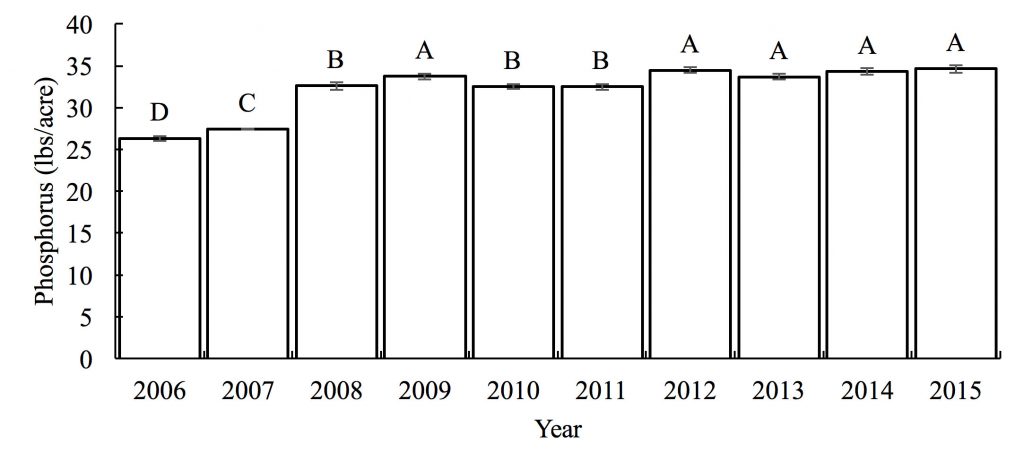Bulletin #1082, High Phosphorus Levels Build Up in Soils of Aroostook County, Maine: Importance for Potato Growers
Developed by Lakesh Sharma, University of Maine Cooperative Extension Assistant Professor of Sustainable Agriculture, and Sukhwinder Bali, Assistant Professor of Sustainable Agriculture, University of Maine Cooperative Extension
For information about UMaine Extension programs and resources, visit extension.umaine.edu.
Find more of our publications and books at extension.umaine.edu/publications/.
Why soil phosphorus (P) levels matter to Aroostook County potato farmers
Potatoes are highly sensitive to P levels. Potatoes do not demand high soil P. In Aroostook County, Maine, the maximum P removal by potatoes was recorded as ~19–20 pounds/acre. However, P deficiency can seriously hamper the yield potential of this crop. Phosphorus is a crucial element for potatoes for early root formation and shoot development. The number of tubers formed, which is highly important to seed growers, depends heavily on adequate P supply.
Importance of potato crops in Maine
Potatoes are Maine’s most valuable agricultural commodity, worth almost $174 million per year. About 47,000 acres of potatoes are grown in Maine, 90% of which are grown in Aroostook County.1
What was done
UMaine Extension analyzed data from soils sampled from Aroostook County between 2006 and 2015 to determine the levels of P in the rooting zone. Each year, mostly in spring and autumn, farmers and home gardeners send soil samples to UMaine Soil Lab. The lab processes an average of ~1,100 potato soil samples yearly. The lab provides chemical analysis and fertilizer recommendations relevant to the intended crop. The majority of samples tested from Aroostook County during this period were intended to grow potatoes.
Recommended soil phosphorus level for potatoes
The UMaine Cooperative Extension guidelines for optimum soil test P for potatoes are 10–25 parts per million (ppm) or 20–50 lbs/acre.
P levels in Aroostook County potato fields
Our analysis found a significant increase in average soil P levels in the rooting layer over 10 years (Figure 1). The highest average soil P was recorded in 2015 (35 lbs/acre) and the lowest average soil P occurred in 2006 (26 lbs/acre).

Although there was an overall trend of soil P buildup, there was a slower rate of increase from 2012 to 2015. The slower rate may have been due to high potato yields and governmental efforts to reduce P rates. Excess soil P can upset the chemical balance of waterways, which can change the kinds of wildlife that can live there.
Several factors may be affecting P rates. The first is that growers apply P to avoid P deficiency due to soil fixation of P and to soil erosion.2 Overapplication is supported by the low cost of P fertilizers.
Another factor in P rates is high levels of soil reactive aluminum (Al), which binds with applied P, leaving less P available for crop uptake.3 Some growers cite this as a reason for overapplication, especially when soil pH is low (5–6), which is common in Maine (typical pH range 4.9–6.0) (Sharma et al., 2017). Aluminum has a very high affinity for P, especially at lower soil pH range (< 5.5), where Al is most chemically active.
If the soil is eroded into a stream or lake, much more phosphate is released from this suspended sediment than is available to crop plants in the field. This is one of the primary reasons why phosphorus is such an important water quality issue. To avoid P erosion, farmers could reduce their P application rates, because historically no response in plant growth was found in the P rate study4 except where P was too low. However, the probability of finding low soil P on commercial potato farms in Aroostook County is quite small because of regular additions of P.

For more information, contact:
Lakesh Sharma, Soil Specialist
Assistant Professor, Extension & Sustainable Agriculture
University of Maine Cooperative Extension, Presque Isle Office
57 Houlton Road
Presque Isle, Maine 04769
Office Phone: 207.764.3361
Fax: 207.764.3362
Cell: 207.498.0316
lakesh.sharma@maine.edu
Lakesh Sharma Staff Directory Listing
1 Data from USDA National Agricultural Statistics Service Quick Stats
2 Sharma, L., S. Bali, and A. Zaeen. 2017. A Case Study of Potential Reasons of Increased Soil Phosphorus Levels in the Northeast United States. Agronomy 7(4): 85. Available at http://www.mdpi.com/2073-4395/7/4/85 (verified 8 May 2018).
3 Magdoff, F. R., C. Hryshko, W. E. Jokela, R. P. Durieux, and Y. Bu. 1999. Comparison of phosphorus soil test extractants for plant availability and environmental assessment. Soil Science Society of America Journal 63: 999–1006.
4 Sharma et al. A case study of potential reasons of increased soil phosphorus levels in the northeast United States.
Information in this publication is provided purely for educational purposes. No responsibility is assumed for any problems associated with the use of products or services mentioned. No endorsement of products or companies is intended, nor is criticism of unnamed products or companies implied.
© 2018
Call 800.287.0274 (in Maine), or 207.581.3188, for information on publications and program offerings from University of Maine Cooperative Extension, or visit extension.umaine.edu.
In complying with the letter and spirit of applicable laws and pursuing its own goals of diversity, the University of Maine System does not discriminate on the grounds of race, color, religion, sex, sexual orientation, transgender status, gender, gender identity or expression, ethnicity, national origin, citizenship status, familial status, ancestry, age, disability physical or mental, genetic information, or veterans or military status in employment, education, and all other programs and activities. The University provides reasonable accommodations to qualified individuals with disabilities upon request. The following person has been designated to handle inquiries regarding non-discrimination policies: Director of Institutional Equity and Title IX Services, 5713 Chadbourne Hall, Room 412, University of Maine, Orono, ME 04469-5713, 207.581.1226, TTY 711 (Maine Relay System).

